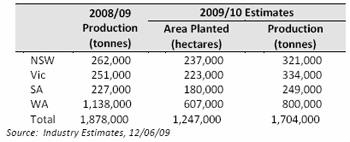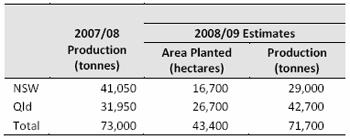|
Australian canola, soybean and sunflower crop report
Australia
June 16, 2009
Source: Australian Oilseeds Federation (AOF)
Canola 2009/10
 In NSW estimates are up on last month on the back of good rains across most of the growing area. Plantings in the North West are up on previous years, with a good moisture profile after rains. On the Liverpool Plains it is a little drier with profiles at about 60%. Good rains in the Central West, ranging from 30-60 mm has provided a very good start. The recent rain has assisted the later planted crops in this region. In the South West, there has been good soaking rain – 30-70mm, which has assisted early growth (currently at 2-8 leaf stage), but the rain has yet to penetrate to subsoil levels in many areas. Earlier planted crops are at close to full ground cover. Insect levels are reported to be low. In NSW estimates are up on last month on the back of good rains across most of the growing area. Plantings in the North West are up on previous years, with a good moisture profile after rains. On the Liverpool Plains it is a little drier with profiles at about 60%. Good rains in the Central West, ranging from 30-60 mm has provided a very good start. The recent rain has assisted the later planted crops in this region. In the South West, there has been good soaking rain – 30-70mm, which has assisted early growth (currently at 2-8 leaf stage), but the rain has yet to penetrate to subsoil levels in many areas. Earlier planted crops are at close to full ground cover. Insect levels are reported to be low.
In Victoria, there has also been good solid rain, particularly in the Wimmera and Western District, which is reflected in the forecast through slightly higher yields. There is still the possibility of further plantings in the Western District. South Australia is also looking promising, with the Mallee in good shape and the S.E. very good.
Western Australia has received rainfall in the past few days which is supporting the current crop estimates. In the
southern and higher rainfall zones, the month of May was favourable with between 25 and 100mm of rainfall, although below average for the month, sufficient when combined with stored subsoil moisture, for the planting and germination of the canola crop.
Soybean 2008/09
 Northern Queensland still has some harvesting underway, with quality and yields holding up well despite rains. Approximately 60% of the crop is destined for the culinary market, the balance for crushing. Protein levels are high in the mid 40% range, with the physical appearance certainly up to edible quality. There are good opportunities in this region to further develop grower skills in order to optimise yields, as there are good expectations of further planting next season The output in Central Queensland has been good, with most Northern Queensland still has some harvesting underway, with quality and yields holding up well despite rains. Approximately 60% of the crop is destined for the culinary market, the balance for crushing. Protein levels are high in the mid 40% range, with the physical appearance certainly up to edible quality. There are good opportunities in this region to further develop grower skills in order to optimise yields, as there are good expectations of further planting next season The output in Central Queensland has been good, with most
growers able to deliver to contract, with good quality beans, with even those destined for crushing being of suitable quality for flour. In the Lockyer, insect damage has knocked yields back by 5-10%. On the Downs, the lack of on-going water after initial germination and growth stages has kept yields back from their potential. The quality, however, is high with good protein levels. Again, there is the opportunity for further grower education to optimise yields through achieving a better balance between foliage growth/bulk and bean moisture. The AOF Better Oilseeds project will work to address the education needs in Qld.
In NSW, harvest is complete everywhere except the North Coast where a few hundred hectares are yet to be harvested. The quality of beans is very good considering torrential rains and at times, flooded crops. Yields have held up well, with around 50% of the North Coast crop destined for the edible market, 50% for crushing. The ability of the beans to survive the very wet/flooding conditions has served to boost the confidence of cane growers in regard to soybeans, as their cane crops were affected by the weather. Elsewhere in the state, the season is all but over, with no significant changes to previous forecasts.
Sunflowers 2008/09
T here has been no change to the estimates or commentary from last month. here has been no change to the estimates or commentary from last month.
In NSW, harvest of the late sunflowers is nearly complete in the Liverpool Plains. Oil content has been very good at 43-44%, with yields at 2.1t/ha. Further north, the yields around Moree have been disappointing, averaging 1.2t/ha. Dry conditions since Easter has affected prospects for the late planted crops.
In Queensland, the late plant monos and polys in CQ are on track to achieve yield 1mt/ha on dryland. Darling Downs harvest of late mono and poly is in full swing with yields down slightly due to the dry finish.
Global Snaphot
The significant drought related reduction in soybean production in South America is continuing to drive tight stock
positions on global soybean stocks, despite expected record soy production in the US. Lower rapeseed crops in Europe, together with lower imports are expected to place a squeeze on rape stocks in Europe.
In contrast, high levels of soy crushings may lead to a surplus of meal on the global market.
The prospects for improvement on global front hinge on the outcome of the 2010 season- particularly the South American soy season, which runs parallel to the Australian season, and is dependent on favourable weather conditions until end Q1 2010.
Source: Oil World June reports
More news from: Australian Oilseeds Federation
Website: http://www.australianoilseeds.com Published: June 16, 2009 |